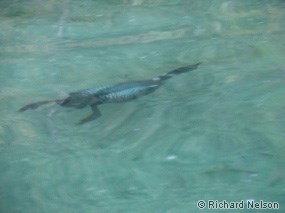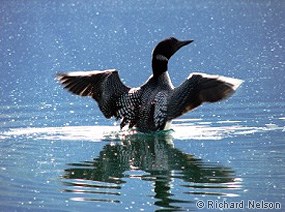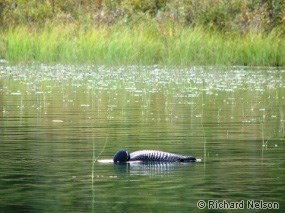|
Common Loon | Northern Beauty | Life Adaptations | Diversity and Preservation 
Built For Water The common loon can submerge for up to a minute in dives that can reach at least 200 feet, making it one the world’s best diving birds. Its powerfully muscled legs are set father back on the body than other birds and the leg bones are somewhat flattened or streamlined to reduce drag on forward strokes when swimming and diving. While most birds have hollow bones to make flight easier, many of the loon’s bones are solid, making them less buoyant and better for swimming and diving. Loons can also compress their feathers to squeeze out trapped air when diving. Loons float low in the water and usually make strong, arching dives; but they can also sink quietly below the surface like a submarine to avoid danger. 
The adaptations that make loons superb divers and swimmers also make them ungainly on land. They walk with their breast low to the ground in a shuffling gait. Koyukon elders teach that loons shouldn’t be eaten by young people or women of childbearing age because it would make them, or their children, clumsy and slow walkers like the loon. Loons cannot take off from land, nor can they burst up from the water like many ducks—they need a long run into the wind to get airborne. Because of this, common loons can only live on large lakes with enough room for takeoff. In more settled parts of the world, loons sometimes mistakenly land on shiny wet highways, and since they can only take off from water they are doomed unless they get help. Once airborne, loons are very fast fliers, averaging 75 miles an hour during migration. Feeding and Breeding Loons rarely come ashore except for mating and nesting or when they are sick or injured. At night they sleep on the water, safe from predators like foxes. Although the adults are relatively secure on nesting lakes, their chicks are vulnerable to many predators such as peregrine falcons. In their winter habitat along the seacoasts, loons are sometimes taken by marine predators like sea otters. 
The lakes and seacoasts which are the loons’ home are also their restaurant—small fish, shrimp, crabs, crayfish, snails, frogs, and water insects make up most of their diet. Common loons often swim with their head underwater, peering side to side, searching for fish or other prey. They dive down and spear or grab prey with their formidably large, sharp, chisel-shaped beak. They can also use their beak as a weapon, even killing other loons who enter their breeding territory. Loons arrive on northern lakes as soon as the ice thaws in the spring. In Gates of the Arctic National Park, lakes become ice-free around mid-May to mid-June, depending on the size of the lake, latitude and altitude. Usually smaller lakes have only one pair of loons, but on larger lakes each pair claims a specific area such as a bay as their territory; often a pair will nest in the same place year after year. Pairs build their nest on a lakeshore beside the water, or on the safety of a small island or mat of floating vegetation. Loon nests are vulnerable to predators like gulls, ravens, mink and foxes, and they can be flooded or washed away by boat wakes. Human activity can also frighten the parents off the nest, so that the eggs chill and the embryos die. The female lays two eggs, and if all goes well the downy chicks are born about a month later. It’s not unusual to see a loon chick safely riding on the back of one of its parents or snuggling under the adult’s wing to keep warm and safe from predators such as pike, gulls, hawks and eagles. Loon chicks grow slowly—it takes about three months before they start diving for their own food and learn to fly. By early September, the lakes in Gates of the Arctic National Park start to freeze and the young birds and adults fly off toward their winter homes. Under the best circumstances a common loon can live 15-30 years. Common Loon | Northern Beauty | Life Adaptations | Diversity and Preservation |
Last updated: April 30, 2021
